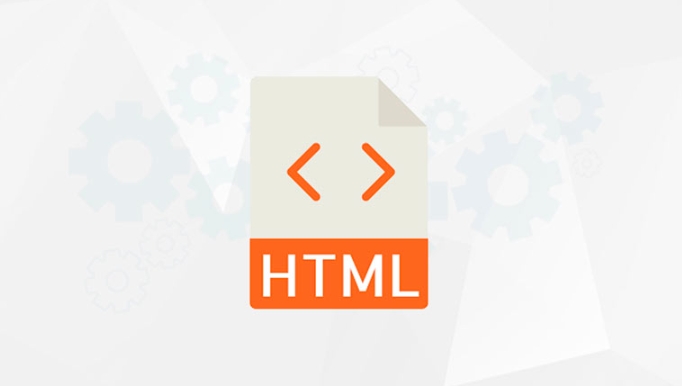HTML5 natively supports drag and drop function, and interacts by setting draggable attributes and listening to dragstart, dragover, and drop events. 1. Set the element draggable="true" to enable drag; 2. Use dataTransfer.setData() to pass data in dragstart; 3. The target area listens to the dragover and blocks the default behavior to allow placement; 4. Get data and process content in the drop event; precautions include cross-domain restrictions, visual feedback, mobile compatibility and file upload support. Mastering these key points can achieve basic drag-and-drop interaction.

The drag and drop function is very practical in web development, especially in scenarios where user interaction is required. HTML5 natively supports drag and drop (drag and drop), and does not require the introduction of additional libraries to achieve basic functions. Below are some key points and operation suggestions to help you get started quickly.

Basic structure of drag and drop
To implement drag and drop, at least two elements are required: a draggable element and a target zone.
By default, only certain HTML elements (such as pictures, links) are draggable, and other elements need to be manually set to draggable="true" to be dragged.
for example:

<div id="dragElem" draggable="true">Drag me</div> <div id="dropZone">Put here</div>
Next is to bind the event listener. The main events used are:
-
dragstart: Triggered when starting dragging -
dragover: Continuously triggered when the dragged element moves above the target area -
drop: Triggered when the mouse is released and the mouse is finished.
Key steps to implement drag and drop
1. Set the behavior of draggable elements

In the dragstart event, you can specify the data passed when dragging. The most common method is to use dataTransfer.setData() method to save data.
document.getElementById('dragElem').addEventListener('dragstart', function(e) {
e.dataTransfer.setData("text/plain", "This is the content of the drag");
});2. Allow elements to be dragged and dropped
By default, most elements do not allow drag and drop content to be received. You need to block the default behavior of dragover in order for drop event to take effect.
document.getElementById('dropZone').addEventListener('dragover', function(e) {
e.preventDefault(); // The default behavior must be blocked, otherwise drop will not fire});3. Handle drag and drop logic
In the drop event, the data passed during the dragging process can be obtained and processed.
document.getElementById('dropZone').addEventListener('drop', function(e) {
e.preventDefault();
const data = e.dataTransfer.getData("text/plain");
e.target.textContent = data; // Show dragged content});Notes and FAQs
- Cross-domain issues : If you are dragging resources from other websites (such as images), you may encounter security restrictions.
- Style feedback : You can add some visual feedback when dragging, such as changing the background color of the target area to improve the user experience.
- Compatibility : Although modern browsers support HTML5 drag and drop APIs, mobile support may be slightly different, and it is recommended to test mainstream devices.
- Multiple drag and drop objects : If you want to support multiple draggable elements, it is best to bind a unified class name or selector for each element to avoid duplicate code.
Tips: Drag and drop file upload
In addition to dragging elements within the page, HTML5 also supports dragging files from locally, such as pictures, text, etc. Just listen to events in drop area and read FileList object.
dropZone.addEventListener('drop', function(e) {
e.preventDefault();
const files = e.dataTransfer.files;
if (files.length > 0) {
const file = files[0];
console.log("Drag in file name:", file.name);
}
}); Basically that's it. Drag and drop seems simple, but there are a lot of details, especially in the event sequence and compatibility that are prone to errors. As long as you understand the role of dragstart , dragover and drop , and cooperate with the data transmission mechanism, you can achieve good interaction effects.
The above is the detailed content of HTML5 drag and drop tutorial. For more information, please follow other related articles on the PHP Chinese website!

Hot AI Tools

Undress AI Tool
Undress images for free

Undresser.AI Undress
AI-powered app for creating realistic nude photos

AI Clothes Remover
Online AI tool for removing clothes from photos.

Clothoff.io
AI clothes remover

Video Face Swap
Swap faces in any video effortlessly with our completely free AI face swap tool!

Hot Article

Hot Tools

Notepad++7.3.1
Easy-to-use and free code editor

SublimeText3 Chinese version
Chinese version, very easy to use

Zend Studio 13.0.1
Powerful PHP integrated development environment

Dreamweaver CS6
Visual web development tools

SublimeText3 Mac version
God-level code editing software (SublimeText3)

Hot Topics
 Audio and Video: HTML5 VS Youtube Embedding
Jun 19, 2025 am 12:51 AM
Audio and Video: HTML5 VS Youtube Embedding
Jun 19, 2025 am 12:51 AM
HTML5isbetterforcontrolandcustomization,whileYouTubeisbetterforeaseandperformance.1)HTML5allowsfortailoreduserexperiencesbutrequiresmanagingcodecsandcompatibility.2)YouTubeofferssimpleembeddingwithoptimizedperformancebutlimitscontroloverappearanceand
 What is the purpose of the input type='range'?
Jun 23, 2025 am 12:17 AM
What is the purpose of the input type='range'?
Jun 23, 2025 am 12:17 AM
inputtype="range" is used to create a slider control, allowing the user to select a value from a predefined range. 1. It is mainly suitable for scenes where values ??need to be selected intuitively, such as adjusting volume, brightness or scoring systems; 2. The basic structure includes min, max and step attributes, which set the minimum value, maximum value and step size respectively; 3. This value can be obtained and used in real time through JavaScript to improve the interactive experience; 4. It is recommended to display the current value and pay attention to accessibility and browser compatibility issues when using it.
 Adding drag and drop functionality using the HTML5 Drag and Drop API.
Jul 05, 2025 am 02:43 AM
Adding drag and drop functionality using the HTML5 Drag and Drop API.
Jul 05, 2025 am 02:43 AM
The way to add drag and drop functionality to a web page is to use HTML5's DragandDrop API, which is natively supported without additional libraries. The specific steps are as follows: 1. Set the element draggable="true" to enable drag; 2. Listen to dragstart, dragover, drop and dragend events; 3. Set data in dragstart, block default behavior in dragover, and handle logic in drop. In addition, element movement can be achieved through appendChild and file upload can be achieved through e.dataTransfer.files. Note: preventDefault must be called
 How can you animate an SVG with CSS?
Jun 30, 2025 am 02:06 AM
How can you animate an SVG with CSS?
Jun 30, 2025 am 02:06 AM
AnimatingSVGwithCSSispossibleusingkeyframesforbasicanimationsandtransitionsforinteractiveeffects.1.Use@keyframestodefineanimationstagesforpropertieslikescale,opacity,andcolor.2.ApplytheanimationtoSVGelementssuchas,,orviaCSSclasses.3.Forhoverorstate-b
 HTML audio and video: Examples
Jun 19, 2025 am 12:54 AM
HTML audio and video: Examples
Jun 19, 2025 am 12:54 AM
Audio and video elements in HTML can improve the dynamics and user experience of web pages. 1. Embed audio files using elements and realize automatic and loop playback of background music through autoplay and loop properties. 2. Use elements to embed video files, set width and height and controls properties, and provide multiple formats to ensure browser compatibility.
 What is WebRTC and what are its main use cases?
Jun 24, 2025 am 12:47 AM
What is WebRTC and what are its main use cases?
Jun 24, 2025 am 12:47 AM
WebRTC is a free, open source technology that supports real-time communication between browsers and devices. It realizes audio and video capture, encoding and point-to-point transmission through built-in API, without plug-ins. Its working principle includes: 1. The browser captures audio and video input; 2. The data is encoded and transmitted directly to another browser through a security protocol; 3. The signaling server assists in the initial connection but does not participate in media transmission; 4. The connection is established to achieve low-latency direct communication. The main application scenarios are: 1. Video conferencing (such as GoogleMeet, Jitsi); 2. Customer service voice/video chat; 3. Online games and collaborative applications; 4. IoT and real-time monitoring. Its advantages are cross-platform compatibility, no download required, default encryption and low latency, suitable for point-to-point communication
 How to create animations on a canvas using requestAnimationFrame()?
Jun 22, 2025 am 12:52 AM
How to create animations on a canvas using requestAnimationFrame()?
Jun 22, 2025 am 12:52 AM
The key to using requestAnimationFrame() to achieve smooth animation on HTMLCanvas is to understand its operating mechanism and cooperate with Canvas' drawing process. 1. requestAnimationFrame() is an API designed for animation by the browser. It can be synchronized with the screen refresh rate, avoid lag or tear, and is more efficient than setTimeout or setInterval; 2. The animation infrastructure includes preparing canvas elements, obtaining context, and defining the main loop function animate(), where the canvas is cleared and the next frame is requested for continuous redrawing; 3. To achieve dynamic effects, state variables, such as the coordinates of small balls, are updated in each frame, thereby forming
 How to check if a browser can play a specific video format?
Jun 28, 2025 am 02:06 AM
How to check if a browser can play a specific video format?
Jun 28, 2025 am 02:06 AM
To confirm whether the browser can play a specific video format, you can follow the following steps: 1. Check the browser's official documents or CanIuse website to understand the supported formats, such as Chrome supports MP4, WebM, etc., Safari mainly supports MP4; 2. Use HTML5 tag local test to load the video file to see if it can play normally; 3. Upload files with online tools such as VideoJSTechInsights or BrowserStackLive for cross-platform detection. When testing, you need to pay attention to the impact of the encoded version, and you cannot rely solely on the file suffix name to judge compatibility.






